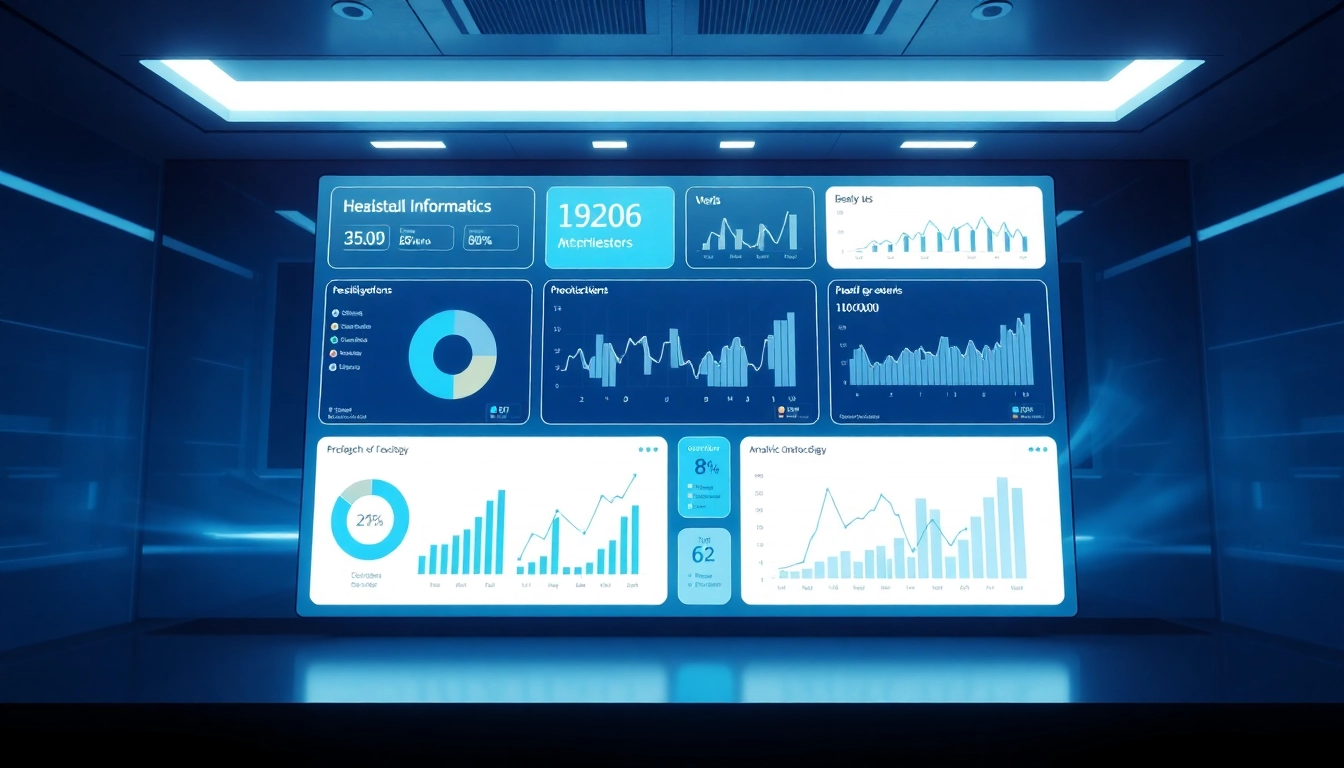Understanding Healthcare Informatics
In an era where technology continuously reshapes our lives, healthcare informatics stands at the forefront of a revolutionary transformation in how healthcare is delivered and managed. Combining data and knowledge representation with information processing technologies, healthcare informatics aims to improve human health outcomes and enhance the overall experience of healthcare professionals and patients alike. www.informaticsview.com serves as a pivotal resource for advancing our understanding of the intersection between healthcare and informatics.
What is Informatics?
Informatics is broadly defined as the science of how to use data, information, and knowledge in a systematic way to improve health outcomes and streamline healthcare processes. It invokes a blend of computing, information science, and healthcare expertise to devise practical solutions that enhance health delivery systems. The core objective is not only to manage health data but to transform it into actionable information that can lead to improved patient care and operational efficiency.
The Role of Data in Health Care
Data plays an indispensable role in healthcare informatics. It encompasses a wide array of forms including clinical data, administrative data, and patient-generated data among others. Each data type contributes uniquely to the healthcare continuum:
- Clinical Data: This data forms the backbone of patient interactions, including diagnoses, prescriptions, and treatment outcomes.
- Administrative Data: Essential for organizations, administrative data aids in operations, billing, and resource allocation.
- Patient-Generated Data: Information emanating from patients, such as wearable device data or patient surveys, enriches the understanding of a patient’s health from their perspective.
Harnessing these differing types of data and integrating them into a cohesive informatics strategy is critical to delivering personalized and effective patient care.
Key Components of Healthcare Informatics
Healthcare informatics comprises several foundational components that work together to enhance care delivery:
- Data Analytics: This involves the use of statistical methods and tools to analyze health data, discover trends, and derive insights that can inform clinical decisions.
- Health Information Technology (HIT): Encompassing the technologies used to store, retrieve, and analyze health data, HIT includes electronic health records (EHRs), telehealth platforms, and health information exchanges (HIEs).
- Clinical Decision Support Systems (CDSS): These are systems designed to provide healthcare professionals with knowledge and patient-specific information, intelligently filtered at appropriate times to enhance patient care.
- User-Centric Design: User experience design is crucial in informatics, ensuring that systems are intuitive and easy to use for healthcare providers and patients, thus improving the adoption of technological solutions.
Importance of Informatics in Modern Healthcare
The integration of informatics into healthcare practices is not just beneficial; it is vital for the contemporary health ecosystem. Below are some of the pivotal ways in which informatics is reshaping modern healthcare.
Improving Patient Outcomes
Healthcare informatics has a profound impact on patient outcomes. By utilizing advanced data analytics and decision support systems, healthcare providers can tailor interventions and treatments to individual patient needs, thus leading to:
- Personalized Medicine: Treatments that are specifically designed based on genetic, environmental, and lifestyle factors.
- Preventative Care: Leveraging data to predict potential health issues and intervene before they become critical.
- Improved Chronic Disease Management: Real-time monitoring and data collection pave the way for better management of chronic conditions, reducing hospital admissions.
Streamlining Clinical Processes
Through the use of informatics, healthcare organizations can significantly streamline clinical processes. Some improvements include:
- Reduction in Administrative Burden: Automation of scheduling, billing, and patient flow management allows healthcare professionals to focus more on patient care.
- Enhanced Communication: Tools like EHRs and telemedicine platforms foster better communication between healthcare teams and patients.
- Real-Time Access to Information: Clinicians can access vital patient information at the point of care, facilitating better and faster decision-making.
Facilitating Health Information Exchange
Health Information Exchange (HIE) is crucial to integrated care delivery. Informatics enables secure sharing of health information between providers, leading to:
- Continuity of Care: Patients receive coherent and coordinated treatment across different care settings.
- Shared Knowledge Base: Collaboration among healthcare professionals ensures up-to-date treatment plans and reduced medical errors.
- Population Health Management: Providers can analyze data across varied demographics to identify health trends and disparities in care.
Innovative Technologies in Healthcare Informatics
The rapid advancement of technology paves the way for innovative solutions in healthcare informatics. This includes the integration of various technical applications aimed at revolutionizing health services.
Artificial Intelligence Applications
Artificial intelligence (AI) is transforming healthcare informatics by enabling machines to learn from data and make informed decisions. Use cases for AI in healthcare include:
- Predictive Analytics: AI algorithms can analyze patient data to forecast future health events, allowing for timely interventions.
- Virtual Health Assistants: AI-powered chatbots and voice recognition systems help in patient triage and appointment scheduling.
- Medical Imaging: AI systems assist radiologists by identifying and diagnosing conditions in imaging data with improved accuracy and speed.
Telemedicine and Remote Monitoring
Telemedicine has gained prominence, especially during crises like the COVID-19 pandemic, by enabling healthcare providers to connect with patients remotely. Key benefits include:
- Accessibility to Care: Remote consultations make healthcare accessible to patients in rural or underserved areas.
- Patient Convenience: Reduces the need for in-person visits, saving time and lowering logistical challenges for patients.
- Continuous Monitoring: Wearable health devices allow for real-time health status tracking and timely interventions when abnormalities arise.
Electronic Health Records (EHR) Systems
EHR systems have revolutionized how patient records are stored and accessed. The advantages of these systems include:
- Comprehensive Data Management: EHRs centralize patient information, making it easily accessible to authorized providers across all health settings.
- Improved Accuracy: Digital records reduce errors associated with paper-based documentation.
- Enhanced Care Coordination: EHRs facilitate the seamless exchange of information among healthcare teams for coordinated care delivery.
Challenges in Implementing Healthcare Informatics
Despite the numerous benefits of healthcare informatics, several challenges can hinder its successful implementation. Recognizing these challenges is crucial for healthcare leaders seeking to leverage informatics effectively.
Data Privacy and Security Concerns
With the increasing amount of sensitive health data being shared and stored digitally, concerns regarding data privacy and security loom large. Key issues include:
- Regulatory Compliance: Organizations must adhere to laws such as HIPAA that set standards for protecting patient information.
- Cybersecurity Risks: Protecting against unauthorized access and cyberattacks is vital, requiring continuous investment in security technologies and training.
- Patient Trust: Ensuring robust data protection measures cultivates patient trust in the use of their health information.
Integration with Existing Systems
Integrating new informatics solutions with legacy systems can present substantial hurdles:
- Interoperability Issues: Different systems may not communicate effectively, leading to fragmented data and services.
- Cost of Upgrades: Many organizations face financial constraints that limit their ability to update or replace outdated systems.
- Complexity of Implementation: Transitioning to new systems involves training staff and ensuring compatibility, which can disrupt operations.
User Adoption and Training
Ensuring that staff members effectively use new informatics systems is critical to success. However, resistance to change and lack of training can hinder adoption:
- Lack of Familiarity: Discomfort with new technologies can create skepticism among employees.
- Inadequate Training Programs: Without comprehensive training initiatives, users may not fully utilize the capabilities of informatics tools.
- Change Management: Successful implementation requires a change management strategy that encourages buy-in from all stakeholders.
Future Trends in Healthcare Informatics
The future of healthcare informatics is bright, with ongoing innovations promising to further enhance patient care and health system efficiency. Here are several crucial trends to watch:
The Rise of Predictive Analytics
Predictive analytics will continue to emerge as a transformative force within healthcare. By leveraging historical data and trends, predictive analytics can help clinicians identify at-risk patients and herd health strategies:
- Risk Stratification: Tailoring interventions for high-risk patients enhances outcomes and reduces costs.
- Resource Allocation: Predictive models help healthcare organizations allocate resources more effectively.
- Clinical Decision-Making: By providing actionable insights, predictive analytics supports better clinical decision-making.
Enhanced Decision Support Tools
Advancements in artificial intelligence and machine learning will yield even more robust clinical decision support tools. These tools will enhance care delivery by:
- Automating Routine Decisions: Reducing the cognitive load on physicians by automating common decision-making processes.
- Providing Contextual Recommendations: Offering personalized recommendations based on real-time patient data.
- Reducing Variation in Care: Helping to ensure standardized protocols are followed to minimize discrepancies in care.
Personalized Medicine Initiatives
The future of healthcare will increasingly focus on personalized medicine. Advances in genomics and molecular biology will enhance the ability to tailor treatments to individual patients, leading to better outcomes, including:
- Targeted Therapies: Designing therapies based on a patient’s genetic makeup.
- Interactive Patient Engagement: Empowering patients through tools that inform them of how personalized treatment options affect them.
- Integration of Social Determinants of Health: Acknowledging how non-clinical factors influence health outcomes.



